Influence of the Cadmium Sulfide Chemical Bath Deposition Temperature on Cadmium Sulfide/Zinc Oxide Thin Films
Abstract
1. Introduction
2. Materials and Methods
2.1. Materials
2.2. Formation of CdS/ZnO Thin Film
2.3. Characterization of Copper Selenide Films
3. Results and Discussion
3.1. Structural Studies
3.2. Elemental Analysis
3.3. Morphological Analysis
3.4. Optical Analysis
3.5. Electrochemical Analysis
4. Conclusions
Author Contributions
Funding
Institutional Review Board Statement
Informed Consent Statement
Data Availability Statement
Conflicts of Interest
References
- Mozetič, M. Surface Modification to Improve Properties of Materials. Materials 2019, 12, 411. [Google Scholar] [CrossRef] [PubMed]
- Pelevin, I.A.; Ozherelkov, D.Y. Special Issue: Surface Modification of Engineering and Functional Materials. Coatings 2022, 12, 1016. [Google Scholar] [CrossRef]
- Ramírez-Amador, R.; Flores-Carrasco, G.; Alcántara-Iniesta, S.; Rodríguez González, J.; García-Teniza, O.; Mercado-Agular, E.; Vásquez-Ortiz, A.B. Structural, Morphological, Optical, and Electrical Characterization of Fluorine Doped Tin Oxide (FTO) Thin Films Synthesized by PSP. Solid State Phenom. 2019, 286, 64–71. [Google Scholar] [CrossRef]
- Moholkar, A.V.; Pawar, S.M.; Rajpure, K.Y.; Patil, P.S.; Bhosale, C.H. Properties of Highly Oriented Spray-Deposited Fluorine-Doped Tin Oxide Thin Films on Glass Substrates of Different Thickness. J. Phys. Chem. Solids 2007, 68, 1981–1988. [Google Scholar] [CrossRef]
- Kucukomeroglu, T.; Bacaksiz, E.; Terzioglu, C.; Varilci, A. Influence of Fluorine Doping on Structural, Electrical and Optical Properties of Spray Pyrolysis ZnS Films. Thin Solid Films 2008, 516, 2913–2916. [Google Scholar] [CrossRef]
- Yokoyama, T.; Masuda, H.; Suzuki, M.; Ehara, K.; Nogi, K.; Fuji, M.; Fukui, T.; Suzuki, H.; Tatami, J.; Hayashi, K.; et al. Basic Properties and Measuring Methods of Nanoparticles. In Nanoparticle Technology Handbook; Elsevier: Amsterdam, The Netherlands, 2008; pp. 3–48. [Google Scholar]
- Pearton, S.J.; Norton, D.P.; Ip, K.; Heo, Y.W.; Steiner, T. Recent Progress in Processing and Properties of ZnO. Superlattices Microstruct. 2003, 34, 3–32. [Google Scholar] [CrossRef]
- Di Bartolomeo, A.; Zin Toe, M.; Kian Tan, W.; Muto, H.; Kawamura, G.; Matsuda, A.; Aisha Binti Yaacob, K.; Pung, S.-Y. Effect of Carrier Gas Flow Rates on the Structural and Optical Properties of ZnO Films Deposited Using an Aerosol Deposition Technique. Electron. Mater. 2022, 3, 332–343. [Google Scholar] [CrossRef]
- Fang, X.; Bando, Y.; Gautam, U.K.; Zhai, T.; Zeng, H.; Xu, X.; Liao, M.; Golberg, D. ZnO and ZnS Nanostructures: Ultraviolet-Light Emitters, Lasers, and Sensors. Crit. Rev. Solid State Mater. Sci. 2009, 34, 190–223. [Google Scholar] [CrossRef]
- Li, B.; Wang, Y. Synthesis, Microstructure, and Photocatalysis of ZnO/CdS Nano-Heterostructure. J. Phys. Chem. Solids 2011, 72, 1165–1169. [Google Scholar] [CrossRef]
- Hoffmann, M.R.; Martin, S.T.; Choi, W.; Bahnemann, D.W. Environmental Applications of Semiconductor Photocatalysis. Chem. Rev. 1995, 95, 69–96. [Google Scholar] [CrossRef]
- Willander, M.; Nur, O.; Fakhr-e-Alam, M.; Atif, M.; AlSalhi, M.S. ZnO Nanostructures: Toxicity and Phototoxicity Characteristics in Biological Samples. In Zinc Oxide Nanostructures: Advances and Applications; Jenny Stanford Publishing: Dubai, United Arab Emirates, 2014; pp. 157–184. ISBN 9789814411349. [Google Scholar]
- Bao, Q.; Liu, X.; Xia, Y.; Gao, F.; Kauffmann, L.D.; Margeat, O.; Ackermann, J.; Fahlman, M. Effects of Ultraviolet Soaking on Surface Electronic Structures of Solution Processed ZnO Nanoparticle Films in Polymer Solar Cells. J. Mater. Chem. A 2014, 2, 17676–17682. [Google Scholar] [CrossRef]
- Sypniewska, M.; Szczesny, R.; Popielarski, P.; Strzalkowski, K.; Derkowska-Zielinska, B. Structural, Morphological and Photoluminescent Properties of Annealed ZnO Thin Layers Obtained by the Rapid Sol-Gel Spin-Coating Method. Opto-Electron. Rev. 2020, 28, 182–190. [Google Scholar] [CrossRef]
- Hameed, T.A.; Sharmoukh, W.; Anis, B.; Youssef, A.M. Enhanced Photocatalytic Activity and Diode Performance of ZnO-GO Nanocomposites via Doping with Aluminum. Int. J. Energy Res. 2022, 46, 22601–22624. [Google Scholar] [CrossRef]
- Xu, F.; Volkov, V.; Zhu, Y.; Bai, H.; Rea, A.; Valappil, N.V.; Su, W.; Gao, X.; Kuskovsky, I.L.; Matsui, H. Long Electron—Hole Separation of ZnO-CdS Core—Shell Quantum Dots. J. Phys. Chem. C Nanomater. Interfaces 2013, 113, 19419–19423. [Google Scholar] [CrossRef]
- Weinhardt, L.; Heske, C.; Umbach, E.; Niesen, T.P.; Visbeck, S.; Karg, F. Band Alignment at the I-ZnO/CdS Interface in Cu(In,Ga)(S,Se) 2 Thin-Film Solar Cells. Appl. Phys. Lett. 2004, 84, 3175–3177. [Google Scholar] [CrossRef]
- Sadovnikov, S.I.; Rempel, A.A.; Gusev, A.I. Nanostructured Lead, Cadmium, and Silver Sulfides; Springer Series in Materials Science; Springer International Publishing: Cham, Switerland; Berlin/Heidelberg, Germany, 2018; Volume 256, pp. 127–188. ISBN 978-3-319-56386-2. [Google Scholar]
- Murray, C.B.; Norris, D.J.; Bawendi, M.G. Synthesis and Characterization of Nearly Monodisperse CdE (E = S, Se, Te) Semiconductor Nanocrystallites. J. Am. Chem. Soc. 1993, 115, 8706–8715. [Google Scholar] [CrossRef]
- Supekar, A.; Kapadnis, R.; Bansode, S.; Bhujbal, P.; Kale, S.; Jadkar, S.; Pathan, H. Cadmium Telluride/Cadmium Sulfide Thin Films Solar Cells: A Review. ES Energy Environ. 2020, 10, 3–12. [Google Scholar] [CrossRef]
- Wu, Y.; Tamaki, T.; Volotinen, T.; Belova, L.; Rao, K.V. Enhanced Photoresponse of Inkjet-Printed ZnO Thin Films Capped with CdS Nanoparticles. J. Phys. Chem. Lett. 2010, 1, 89–92. [Google Scholar] [CrossRef]
- Tak, Y.; Hong, S.J.; Lee, J.S.; Yong, K. Fabrication of ZnO/CdS Core/Shell Nanowire Arrays for Efficient Solar Energy Conversion. J. Mater. Chem. 2009, 19, 5945–5951. [Google Scholar] [CrossRef]
- Bragg, W.H.; Bragg, W.L. The Reflection of X-Rays by Crystals. Proc. R. Soc. Lond. Ser. A Contain. Pap. A Math. Phys. Character 1913, 88, 428–438. [Google Scholar] [CrossRef]
- Patterson, A.L. The Scherrer Formula for X-Ray Particle Size Determination. Phys. Rev. 1939, 56, 978. [Google Scholar] [CrossRef]
- Nath, D.; Singh, F.; Das, R. X-ray Diffraction Analysis by Williamson-Hall, Halder-Wagner and Size-Strain Plot Methods of CdSe Nanoparticles—A Comparative Study. Mater. Chem. Phys. 2020, 239, 122021. [Google Scholar] [CrossRef]
- Tauc, J.; Grigorovici, R.; Vancu, A. Optical Properties and Electronic Structure of Amorphous Germanium. Phys. Status Solidi 1966, 15, 627–637. [Google Scholar] [CrossRef]
- Makuła, P.; Pacia, M.; Macyk, W. How To Correctly Determine the Band Gap Energy of Modified Semiconductor Photocatalysts Based on UV-Vis Spectra. J. Phys. Chem. Lett. 2018, 9, 6814–6817. [Google Scholar] [CrossRef]
- Lam, K.-T.; Hsiao, Y.-J.; Ji, L.-W.; Fang, T.-H.; Hsiao, K.-H.; Chu, T.-T. High-Sensitive Ultraviolet Photodetectors Based on ZnO Nanorods/CdS Heterostructures. Nanoscale Res. Lett. 2017, 12. [Google Scholar] [CrossRef]
- Lavand, A.B.; Malghe, Y.S. Visible Light Photocatalytic Degradation of 4-Chlorophenol Using C/ZnO/CdS Nanocomposite. J. Saudi Chem. Soc. 2015, 19, 471–478. [Google Scholar] [CrossRef]
- Adegoke, K.A.; Iqbal, M.; Louis, H.; Bello, O.S. Synthesis, Characterization and Application of CdS/ZnO Nanorod Heterostructure for the Photodegradation of Rhodamine B Dye. Mater. Sci. Energy Technol. 2019, 2, 329–336. [Google Scholar] [CrossRef]
- Sankhla, A.; Sharma, R.; Yadav, R.S.; Kashyap, D.; Kothari, S.L.; Kachhwaha, S. Biosynthesis and Characterization of Cadmium Sulfide Nanoparticles—An Emphasis of Zeta Potential Behavior Due to Capping. Mater. Chem. Phys. 2016, 170, 44–51. [Google Scholar] [CrossRef]
- Kim, J.I.; Kim, J.; Lee, J.; Jung, D.-R.; Kim, H.; Choi, H.; Lee, S.; Byun, S.; Kang, S.; Park, B. Photoluminescence Enhancement in CdS Quantum Dots by Thermal Annealing. Nanoscale Res. Lett. 2012, 7, 482. [Google Scholar] [CrossRef]
- Zou, Z.; Xie, C.; Zhang, S.; Yang, C.; Zhang, G.; Yang, L. CdS/ZnO Nanocomposite Film and Its Enhanced Photoelectric Response to UV and Visible Lights at Low Bias. Sens. Actuators B Chem. 2013, 188, 1158–1166. [Google Scholar] [CrossRef]
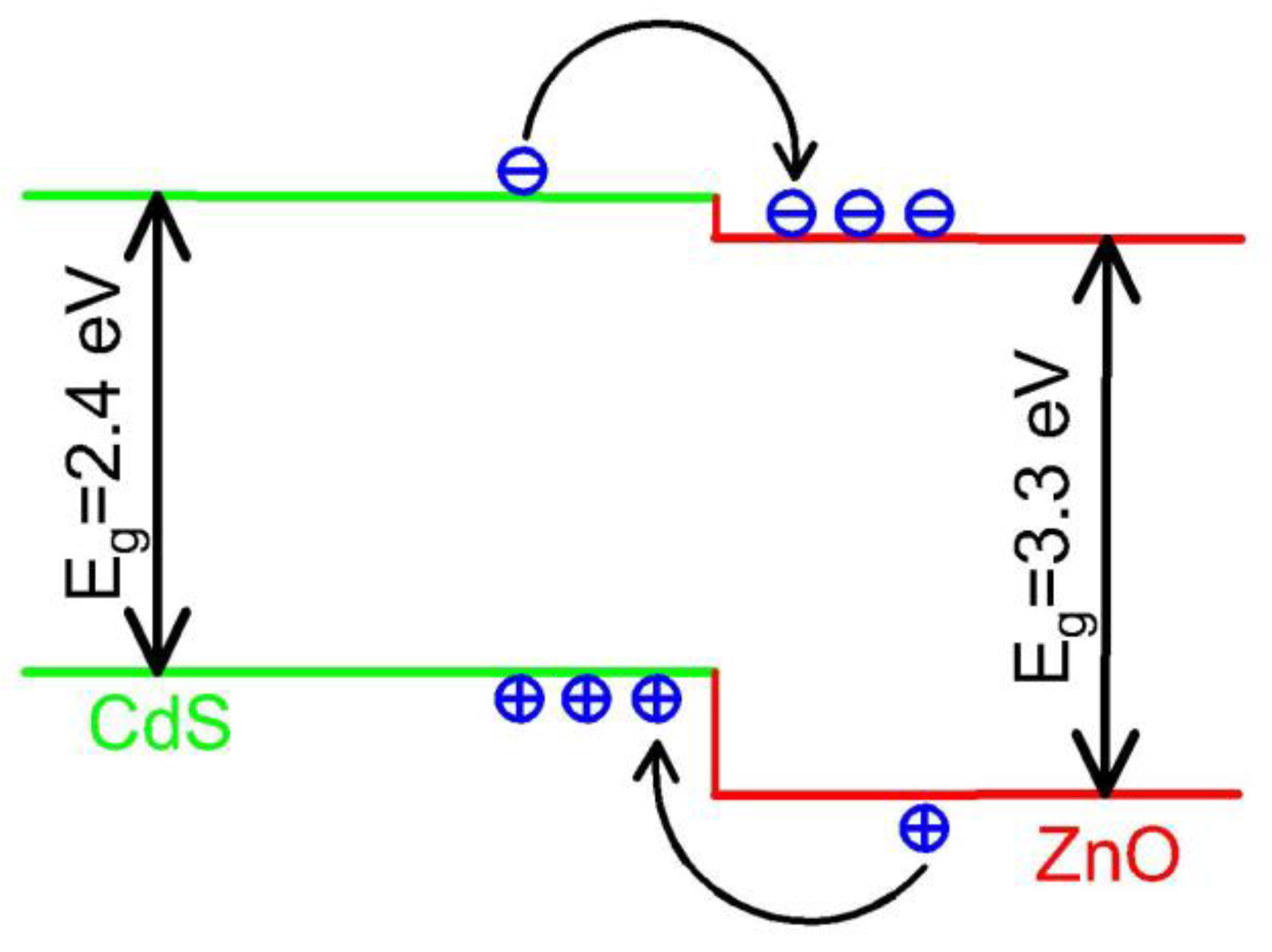

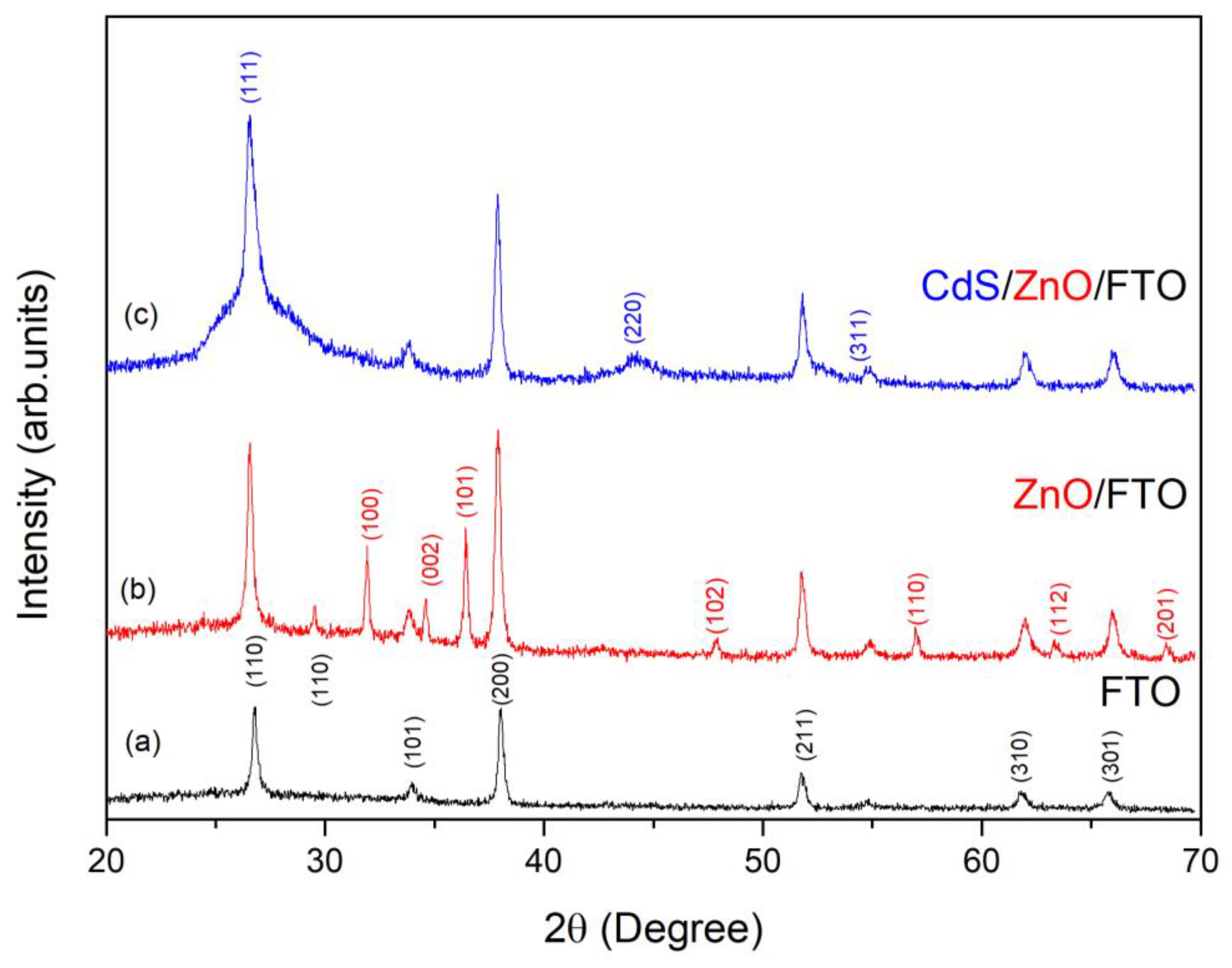
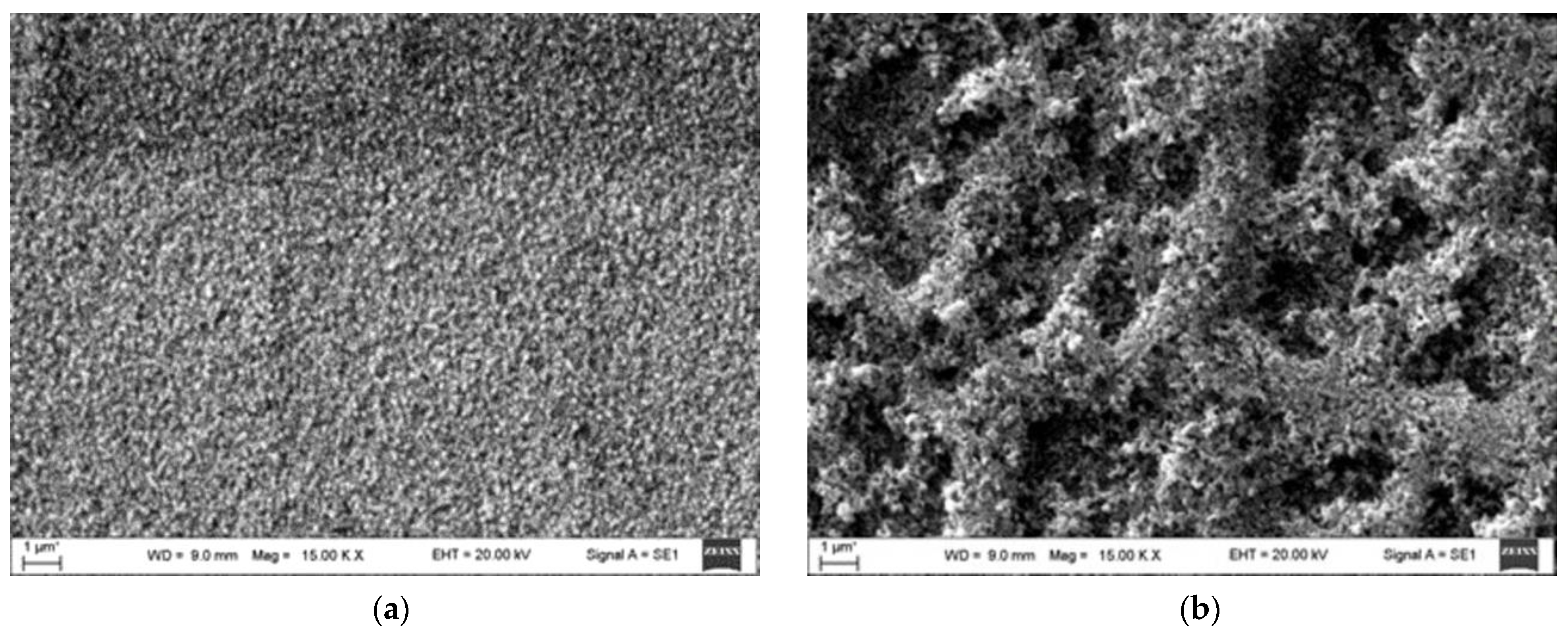
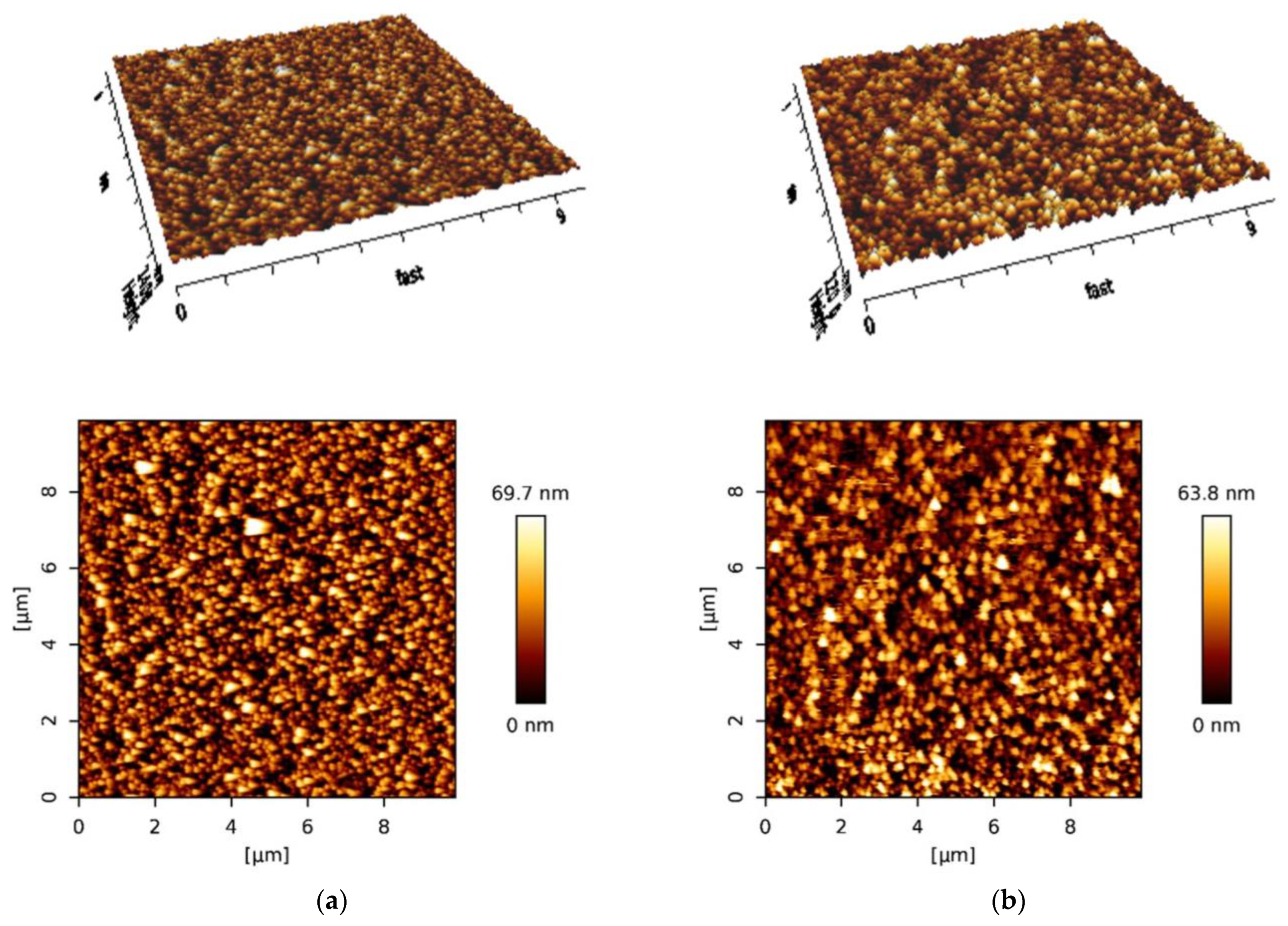



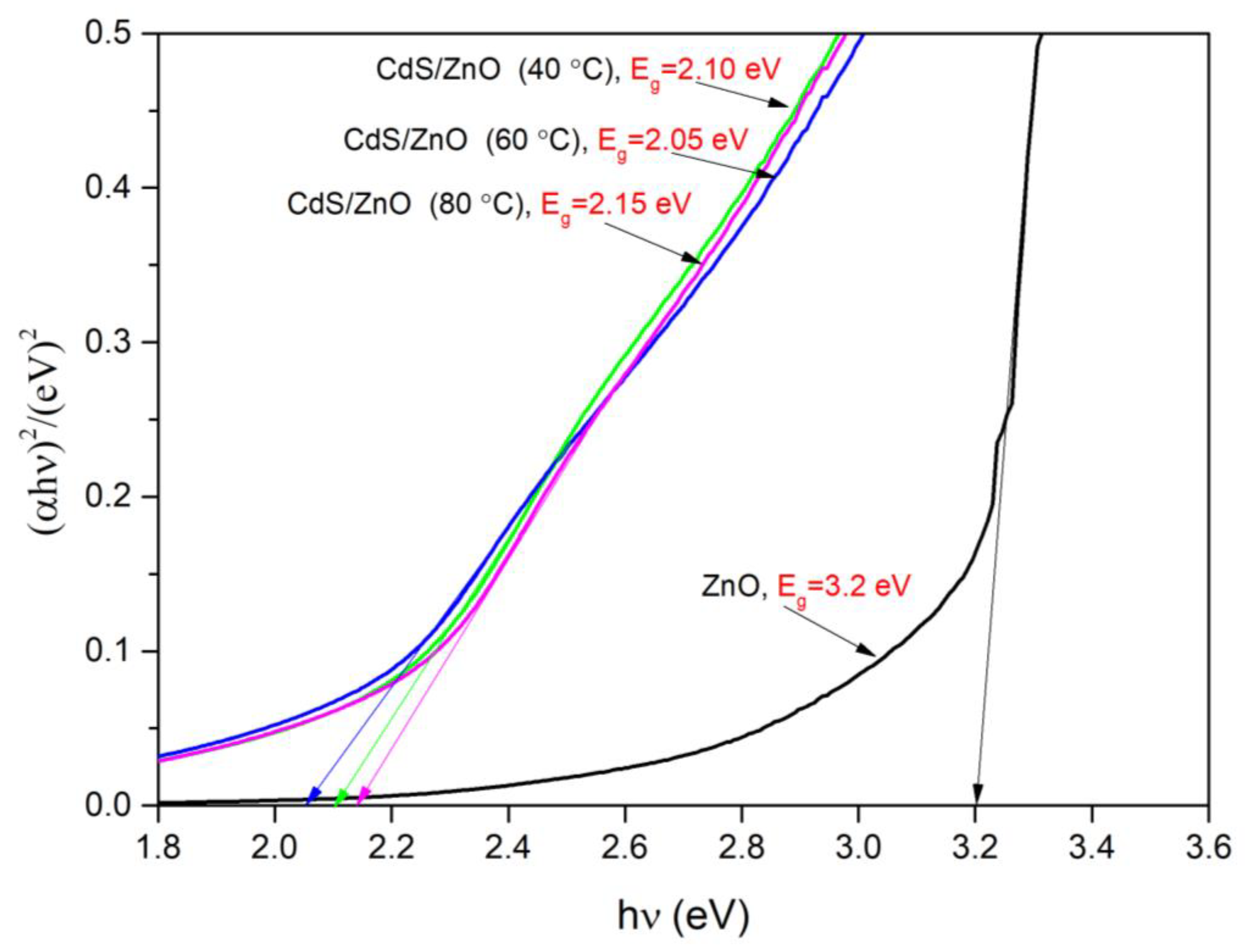

| Peaks Assigned to Materials | Analysis Results | JCPDS Data | ||||
|---|---|---|---|---|---|---|
| 2θ | d, Ǻ | d, Ǻ | Miller Indexes (hkl) | PDF No. | Crystalline Phase | |
| FTO | 26.78 | 3.33 | 3.35 | (110) | 71-0652 | Cassiterite SnO2 tetragonal |
| 33.96 | 2.64 | 2.64 | (101) | |||
| 37.98 | 2.37 | 2.37 | (200) | |||
| 51.75 | 1.77 | 1.76 | (211) | |||
| 61.99 | 1.50 | 1.49 | (310) | |||
| 65.82 | 1.42 | 1.42 | (301) | |||
| ZnO | 31.94 | 2.80 | 2.81 | (100) | 36-1451 | Wurtzite ZnO hexagonal |
| 34.61 | 2.59 | 2.60 | (002) | |||
| 36.42 | 2.46 | 2.48 | (101) | |||
| 47.94 | 1.89 | 1.91 | (102) | |||
| 57.05 | 1.61 | 1.62 | (110) | |||
| 63.29 | 1.47 | 1.47 | (112) | |||
| 68.37 | 1.37 | 1.38 | (201) | |||
| CdS | 26.56 | 3.35 | 3.37 | (111) | 75-0581 | CdS cubic |
| 44.26 | 2.04 | 2.02 | (220) | |||
| 54.893 | 1.67 | 1.68 | (311) | |||
| CdS Layer Forming Temperature | Amount of Elements Wt, % | Molar Ratio of Cd/S | |
|---|---|---|---|
| Cd | S | ||
| 40 °C | 48.13 | 16.72 | 1.22 |
| 60 °C | 51.06 | 17.83 | 1.22 |
| 80 °C | 30.30 | 17.79 | 2.06 |
| Parameters | Smooth Part of Sample | |||
|---|---|---|---|---|
| A, nm | Rq, nm | Rsk, nm | ||
| Cleaned FTO glass substrate | 12.6 | 15.9 | 143.3 | |
| ZnO/FTO | 11.5 | 14.5 | 124.5 | |
| CdS/ZnO/FTO | 40 °C | 118.9 | 150.2 | 1158.0 |
| 60 °C | 84.55 | 107.7 | 882.2 | |
| 80 °C | 104.1 | 135.8 | 1250.0 | |
| CdS Forming Temperature | Sample Surface Area A, cm2 | Current Density juv Value Achieved Using UV Radiation, mA/cm2 | Current Density jt Value Achieved in the Dark, mA/cm2 | juv/jt | Photocurrent jphoto, mA/cm2 |
|---|---|---|---|---|---|
| 40 °C | 1.05 | 0.004 | 0.0007 | 5.71 | 0.003 |
| 60 °C | 1.05 | 0.058 | 0.0065 | 8.92 | 0.052 |
| 80 °C | 0.7 | 0.003 | 0.0002 | 15.00 | 0.003 |
Disclaimer/Publisher’s Note: The statements, opinions and data contained in all publications are solely those of the individual author(s) and contributor(s) and not of MDPI and/or the editor(s). MDPI and/or the editor(s) disclaim responsibility for any injury to people or property resulting from any ideas, methods, instructions or products referred to in the content. |
© 2023 by the authors. Licensee MDPI, Basel, Switzerland. This article is an open access article distributed under the terms and conditions of the Creative Commons Attribution (CC BY) license (https://creativecommons.org/licenses/by/4.0/).
Share and Cite
Usoviene, E.; Petrasauskiene, N.; Jakubauskas, G.; Paluckiene, E. Influence of the Cadmium Sulfide Chemical Bath Deposition Temperature on Cadmium Sulfide/Zinc Oxide Thin Films. Coatings 2023, 13, 1197. https://doi.org/10.3390/coatings13071197
Usoviene E, Petrasauskiene N, Jakubauskas G, Paluckiene E. Influence of the Cadmium Sulfide Chemical Bath Deposition Temperature on Cadmium Sulfide/Zinc Oxide Thin Films. Coatings. 2023; 13(7):1197. https://doi.org/10.3390/coatings13071197
Chicago/Turabian StyleUsoviene, Egle, Neringa Petrasauskiene, Gediminas Jakubauskas, and Edita Paluckiene. 2023. "Influence of the Cadmium Sulfide Chemical Bath Deposition Temperature on Cadmium Sulfide/Zinc Oxide Thin Films" Coatings 13, no. 7: 1197. https://doi.org/10.3390/coatings13071197
APA StyleUsoviene, E., Petrasauskiene, N., Jakubauskas, G., & Paluckiene, E. (2023). Influence of the Cadmium Sulfide Chemical Bath Deposition Temperature on Cadmium Sulfide/Zinc Oxide Thin Films. Coatings, 13(7), 1197. https://doi.org/10.3390/coatings13071197







